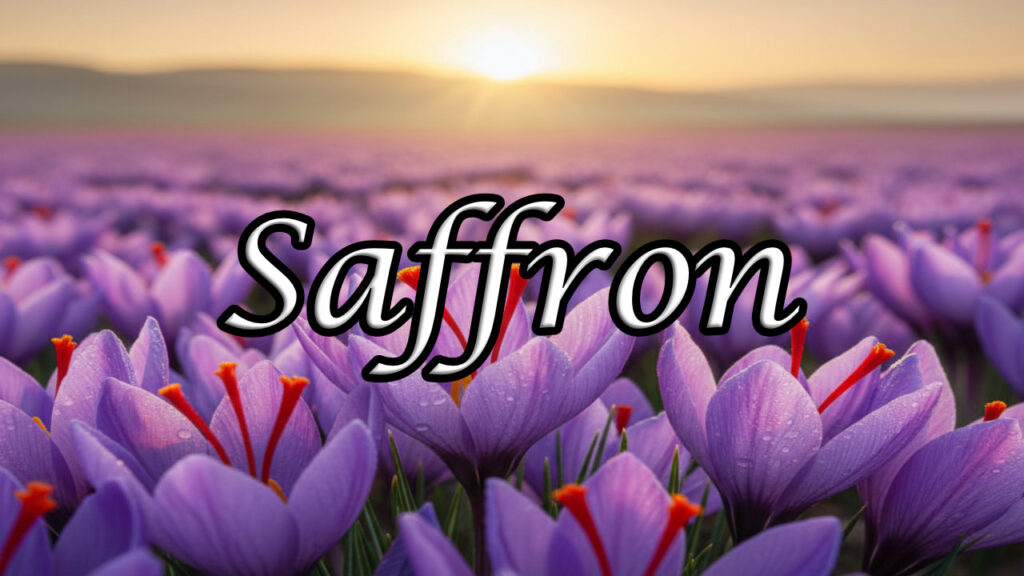
Key Takeaways: Saffron’s Powerful Benefits at a Glance
- Saffron contains potent compounds like crocin and safranal that have been scientifically proven to help alleviate depression symptoms comparable to some medications.
- The world’s most expensive spice requires harvesting over 75,000 flowers to produce just one pound, contributing to its premium price and exclusivity.
- Regular consumption of saffron has been linked to improved memory function and potential protection against neurodegenerative conditions.
- Research shows saffron can significantly reduce PMS symptoms including mood swings and physical discomfort through its impact on hormonal balance.
- Beyond culinary uses, saffron offers powerful anti-inflammatory and antioxidant properties that support overall health and longevity.
The Precious Red Threads That Cost More Than Gold
Saffron is worth more than its weight in gold, and for good reason. These delicate crimson threads are the dried stigmas of the Crocus sativus flower, a member of the iris family that blooms for just one week each year. Each vibrant purple flower produces only three tiny stigmas that must be hand-harvested with extreme care and precision during the early morning hours before the blooms wilt in the sun.
The origins of saffron trace back over 3,500 years to ancient civilizations that valued it not just as a culinary ingredient but as medicine, dye, and perfume. Cleopatra reportedly bathed in saffron-infused water to enhance her beauty, while Alexander the Great used it to treat battle wounds. Today, this precious spice continues to captivate our senses with its distinctive aroma described as honey-like with grassy undertones, its slightly bitter-sweet flavor, and its ability to transform dishes with its magnificent golden hue.
Beyond its sensory appeal, saffron has earned its place in modern wellness practices due to its remarkable concentration of bioactive compounds that offer a wealth of health benefits. The spice’s vibrant color comes from crocin and crocetin, carotenoid compounds with powerful antioxidant properties, while its distinctive aroma derives from safranal – all of which contribute to saffron’s impressive therapeutic potential.
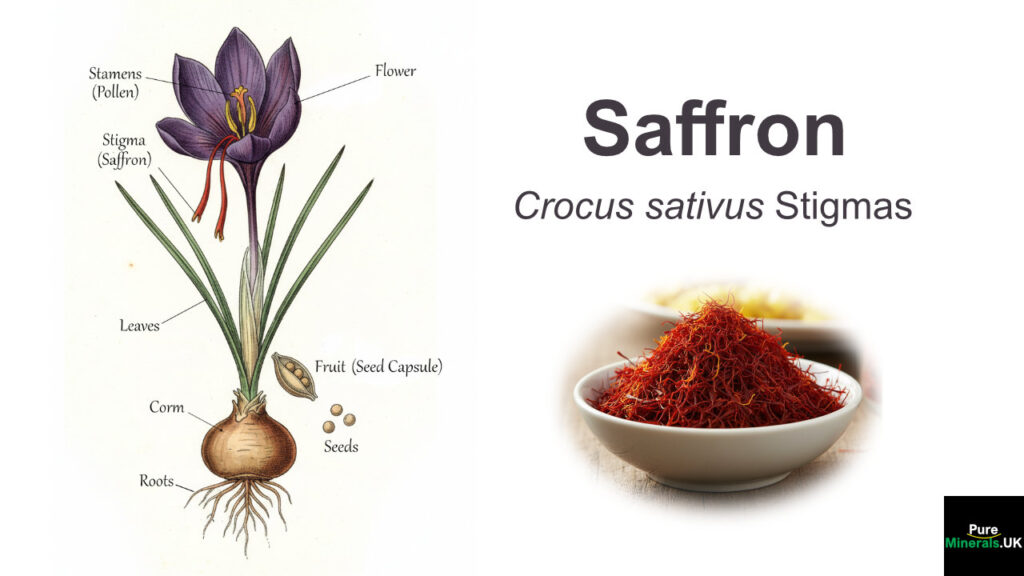
Why Saffron Commands Such a High Price
The astronomical price of saffron – often ranging from $5,000 to $10,000 per pound – reflects the extraordinary labor and precision required for its production. No machinery can replace human hands in this delicate process, making saffron cultivation one of the most labor-intensive agricultural endeavors in the world.
The Labor-Intensive Harvesting Process
The journey of saffron from flower to spice jar involves meticulous handwork at every stage. Skilled harvesters must bend for hours, carefully plucking flowers at precisely the right moment when they’re fully open but before they wilt. Each flower is then gently opened to extract just three thread-like stigmas, which must be handled with extraordinary care to prevent damage. A skilled harvester can process perhaps 1,000 flowers per day – yielding just a few grams of the finished spice.
After collection, the stigmas must be dried immediately to preserve their flavor, aroma, and medicinal properties. Traditional methods involve air-drying in the shade or over low heat sources, with constant monitoring to ensure perfect dehydration without burning. This labor of love transforms the fresh, moist stigmas into the brittle, deep-red threads that grace the world’s finest dishes and medicinal preparations.
“When you understand that each flower offers just three stigmas, and these must be harvested by hand during a very brief annual window, you begin to appreciate why true saffron demands respect both in the kitchen and the medicine cabinet. There are no shortcuts to quality.” – Traditional Iranian Saffron Farmer
It Takes 75,000 Flowers to Make One Pound of Saffron
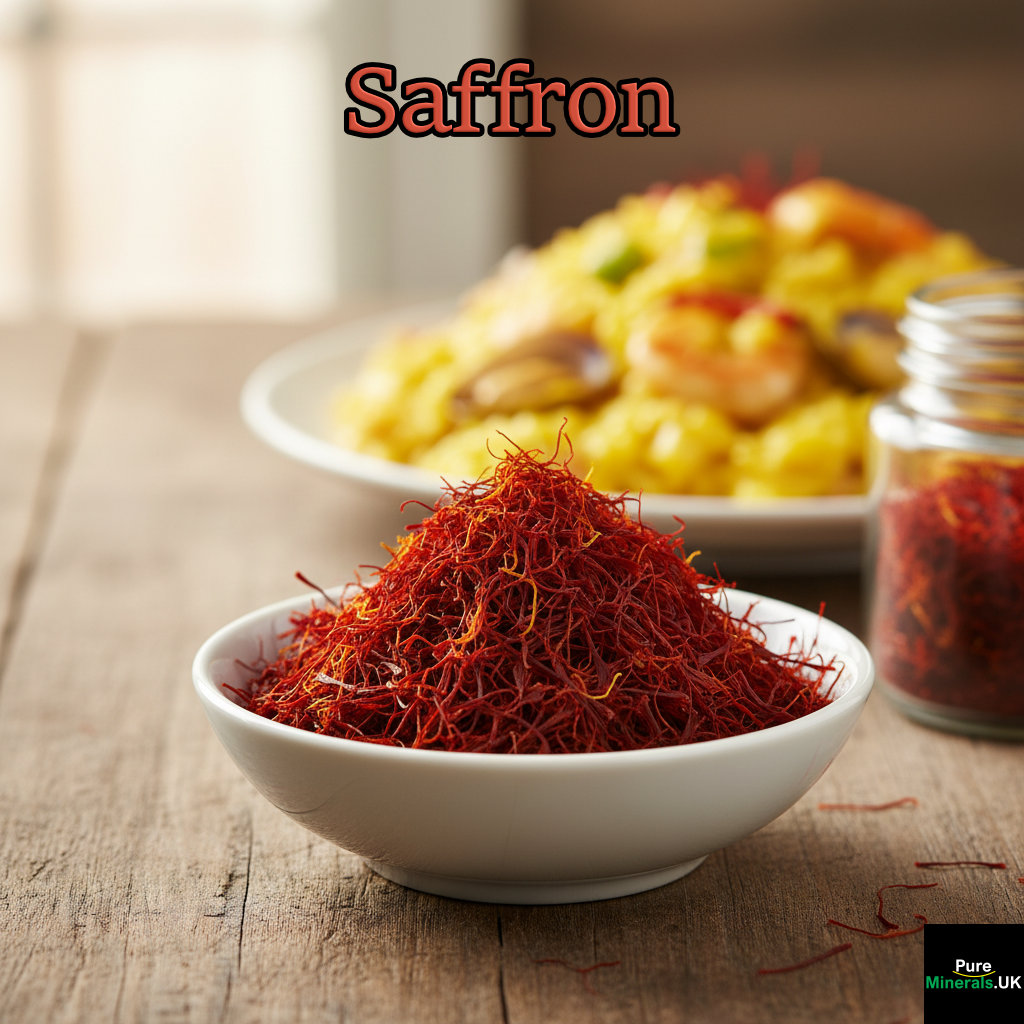
The yield of saffron is almost impossibly small. To produce just one pound (about 450 grams) of dried saffron requires the careful processing of approximately 75,000 Crocus sativus flowers. This remarkable ratio puts into perspective why saffron is sold by the gram rather than by the ounce or pound in most markets around the world.
Consider that a typical saffron farmer might plant and tend thousands of crocus bulbs that bloom for only 1-2 weeks per year. During this fleeting harvest window, every available worker is mobilized for dawn-to-dusk collection and processing. For many saffron-producing families, especially in traditional growing regions like Iran and Kashmir, the annual saffron harvest represents their primary income source – with generations of expertise going into each tiny jar of the finished spice.
When you purchase high-quality saffron, you’re not just buying a spice – you’re investing in an ancient tradition of agricultural artisanship and a product that represents one of the highest concentrations of human labor found in any food item on earth. This exceptional investment in human effort is mirrored by the concentration of beneficial compounds found within each thread.
Limited Growing Regions and Seasonal Availability
Saffron’s cultivation is geographically limited to regions with specific climate conditions, primarily in Iran, Spain, Kashmir, Greece, Morocco, and small areas of Italy. The crocus thrives only in environments with hot, dry summers and cool winters, creating natural limitations on where it can be successfully grown. This geographical constraint further contributes to saffron’s exclusivity and price.
The seasonal nature of saffron adds another layer of complexity to its production. The Crocus sativus blooms for just a few weeks each autumn, creating an urgently short harvesting window that cannot be extended or manipulated. During this brief period, entire communities mobilize to collect the precious flowers before they wilt in the midday sun, making it impossible to mechanize or scale the process in ways that might reduce costs.
Climate change poses a growing threat to traditional saffron-growing regions, with shifting rainfall patterns and temperature fluctuations affecting both yield and quality. Some historical saffron-producing areas have already seen declining harvests, adding pressure to an already limited global supply and further driving prices upward for authentic, high-quality saffron.
The Amazing Health Benefits of Saffron
Beyond its culinary value, saffron has been treasured for millennia for its remarkable health-promoting properties. Modern scientific research has validated many traditional uses while uncovering new potential applications for this extraordinary spice. The therapeutic effects of saffron stem from its rich concentration of bioactive compounds, including crocin, crocetin, picrocrocin, and safranal – each contributing to its impressive health benefits. For those interested in exploring other spices with health benefits, consider learning about oregano, another spice known for its bioactive properties.
Powerful Antidepressant Properties Backed by Science
Perhaps the most well-documented benefit of saffron is its positive effect on mood and mental health. Multiple clinical studies have demonstrated saffron’s effectiveness in alleviating symptoms of mild to moderate depression, with results comparable to conventional antidepressant medications but with fewer side effects. In several randomized controlled trials, participants taking saffron extract showed significant improvements in depression scores compared to placebo groups.
The mood-enhancing effects of saffron appear to work through multiple mechanisms. Research suggests saffron influences serotonin metabolism in the brain, similar to many prescription antidepressants. The active compounds in saffron may inhibit serotonin reuptake, allowing this “feel-good” neurotransmitter to remain active in the brain longer, promoting feelings of wellbeing and emotional balance.
For those experiencing low mood or seasonal affective disorder, incorporating small amounts of saffron into the daily diet might offer gentle support. A typical therapeutic dose in studies ranges from 30-100 mg of high-quality saffron extract daily, though even culinary amounts may offer subtle benefits when consumed regularly.
Clinical research has shown that saffron extract (30mg daily) performed similarly to fluoxetine (20mg daily) in treating mild to moderate depression, but with fewer reported side effects. This makes saffron one of the most promising natural approaches for supporting emotional wellbeing.
Anti-inflammatory and Antioxidant Effects
Saffron contains an impressive array of antioxidant compounds that help neutralize harmful free radicals in the body. The carotenoid pigments that give saffron its distinctive color – primarily crocin and crocetin – demonstrate powerful antioxidant activity that may protect cells from oxidative stress and damage. These protective effects extend to nearly every system in the body, from cardiovascular health to vision protection.
The anti-inflammatory properties of saffron have been demonstrated in numerous laboratory and animal studies, showing potential for alleviating chronic inflammation associated with many health conditions. Inflammation is increasingly recognized as an underlying factor in numerous chronic diseases, including heart disease, diabetes, and arthritis. Regular consumption of small amounts of saffron may help modulate inflammatory responses and support overall health.
In traditional medicine systems, saffron has long been used to soothe digestive discomfort and support liver function. Modern research supports these applications, suggesting that saffron’s anti-inflammatory effects may help calm irritated digestive tissues while its antioxidant properties support healthy liver function and detoxification pathways. For more on natural remedies, explore the benefits of rosemary in traditional medicine.
PMS Symptom Relief and Hormone Balance
Women suffering from premenstrual syndrome (PMS) may find significant relief through saffron supplementation. Clinical research has shown that saffron can effectively reduce both the psychological and physical symptoms associated with PMS, including mood swings, irritability, cravings, and discomfort. In one study, women taking saffron extract reported approximately 50% reduction in PMS symptoms compared to the placebo group.
The hormone-balancing effects of saffron may contribute to its benefits for women’s health. Research suggests saffron may help modulate levels of cortisol (the stress hormone) while supporting healthy estrogen metabolism. This gentle hormonal support may explain why saffron has traditionally been used to regulate menstrual cycles and ease symptoms associated with hormonal transitions.
Beyond PMS relief, preliminary research indicates saffron may offer support during menopause as well. Small studies suggest that saffron supplementation might help reduce hot flashes and improve mood in women experiencing menopausal transitions, though larger clinical trials are needed to confirm these promising findings.
Brain Health Support and Memory Enhancement
The neuroprotective properties of saffron make it particularly valuable for cognitive health and function. Research has demonstrated that regular consumption of saffron may help protect brain cells from oxidative damage while supporting healthy neurotransmitter function. These effects may translate to improved memory, focus, and overall cognitive performance, especially as we age.
Several clinical studies have investigated saffron’s potential benefits for age-related cognitive decline and Alzheimer’s disease. The results are promising – participants receiving saffron extract showed measurable improvements in cognitive function compared to placebo groups. While saffron is certainly not a cure for dementia, its protective effects on brain cells and neurotransmitter systems may help support healthy brain aging.
The memory-enhancing effects of saffron may benefit people of all ages, not just seniors. Students and professionals under mental stress might find that small, regular doses of saffron help optimize focus and cognitive performance while protecting against the negative effects of stress on the brain. Ancient Persian scholars reportedly used saffron to enhance learning and memory – a practice that modern neuroscience is beginning to validate.
How to Spot Real Saffron From Fakes
With saffron’s high price comes the unfortunate reality of counterfeiting and adulteration. Distinguishing genuine saffron from imitations is essential, both for culinary success and to ensure you receive the health benefits this remarkable spice offers. The market is flooded with substitutes including safflower (sometimes called “Mexican saffron”), turmeric-dyed corn silk, and even colored paper cut into threads.
Color, Aroma, and Taste Tests
Authentic saffron threads display a distinctive deep red color, sometimes with a slight orange tinge at one end. When you place saffron threads in warm water, they should slowly release a golden-yellow color without immediately turning the water bright yellow or red – instant coloration often indicates artificial dyes. The threads themselves should not lose their color completely after soaking; they remain distinctly red even after releasing their color compounds, much like how paprika retains its vibrant hue.
The aroma of genuine saffron is complex and unmistakable – a honey-like sweetness with subtle earthy and grassy undertones. Fake saffron often smells musty, has little scent at all, or carries artificial floral notes. When tasting a thread (placed on the tongue for a few seconds), real saffron begins with a slightly bitter taste that evolves into a complex sweetness, leaving a distinctive lingering flavor. Counterfeits typically taste bland, overly bitter, or artificially sweet, much like some mustard varieties that lack authenticity.
Common Counterfeit Versions to Avoid
Safflower (Carthamus tinctorius) is the most common saffron substitute, sometimes deceptively marketed as “Mexican saffron” or “American saffron.” While safflower has its own culinary and medicinal properties, it lacks the unique compounds responsible for saffron’s health benefits and distinctive flavor profile. Visually, safflower threads are more uniformly thin and straight compared to saffron’s trumpet-shaped stigmas.
Other common counterfeit versions include dyed corn silk, which has a more brittle texture than genuine saffron; turmeric-coated threads, which release an intense yellow color immediately when placed in water; and even red-dyed horsehair or plastic threads in the most egregious cases of fraud. Always purchase saffron from reputable sources and be particularly suspicious of unusually low prices – authentic saffron simply cannot be produced cheaply.
Why the Source Matters
The origin of your saffron significantly impacts both its quality and therapeutic potential. Iran produces over 90% of the world’s saffron supply, with the highest grades coming from the Khorasan region. Spanish saffron (often from La Mancha) is also highly regarded, while newer production in places like Kashmir, Greece, and Morocco offers excellent options with distinct regional characteristics.

Reputable suppliers should provide transparency about their saffron’s origin, grade, and harvesting practices. Top-quality saffron is graded according to established standards that consider color strength, flavor intensity, and aroma complexity. For therapeutic purposes, choosing saffron with higher concentrations of bioactive compounds (particularly crocin and safranal) ensures you’ll receive the maximum health benefits this extraordinary spice can offer.
Cooking with Saffron: Tips from Culinary Traditions
Saffron’s culinary magic extends beyond its color and flavor – it connects us to thousands of years of gastronomic tradition across multiple continents. Herbazest notes that saffron’s unique properties can transform ordinary dishes into extraordinary culinary experiences, particularly when proper preparation techniques are employed. Understanding how to handle this precious ingredient ensures you’ll extract maximum flavor, color, and health benefits with minimal waste.
The Essential Saffron Blooming Method
Perhaps the most important technique for cooking with saffron is the “blooming” process, which awakens and distributes the spice’s flavor compounds. Begin by lightly crushing the threads between your fingers to create more surface area. Then steep the crushed threads in a few tablespoons of hot (not boiling) liquid for at least 20 minutes before adding to your recipe. This liquid can be water, broth, milk, or even warm alcohol like vodka, depending on your dish.
This simple step dramatically increases the flavor impact of saffron while ensuring even distribution throughout the dish. The blooming process also activates the water-soluble compounds responsible for many of saffron’s health benefits, making them more bioavailable. For recipes where the visual impact of the threads is desired, reserve a few whole threads to add as a garnish after blooming the majority.
Perfect Pairings for Maximum Flavor
Saffron pairs beautifully with certain ingredients that enhance its unique properties. Aromatic elements like cinnamon, cardamom, and rose water complement saffron’s floral notes in sweet applications. In savory dishes, garlic, onions, and fennel create a foundation that allows saffron’s complex flavor to shine while citrus brightens and amplifies its distinctive profile. For more insights on saffron’s culinary uses, you can explore everything to know about saffron.
Dairy products have a special affinity for saffron – the fat-soluble compounds in milk, cream, and butter readily absorb saffron’s flavor while the smooth texture creates a beautiful canvas for its color. This explains why saffron appears in dairy-based dishes across multiple culinary traditions, from Spanish custards to Indian kesar milk to Italian risotto. Rice also pairs exceptionally well with saffron, absorbing both its golden hue and subtle flavor notes while providing a neutral backdrop.
Classic Saffron Dishes from Around the World
1. Spanish Paella
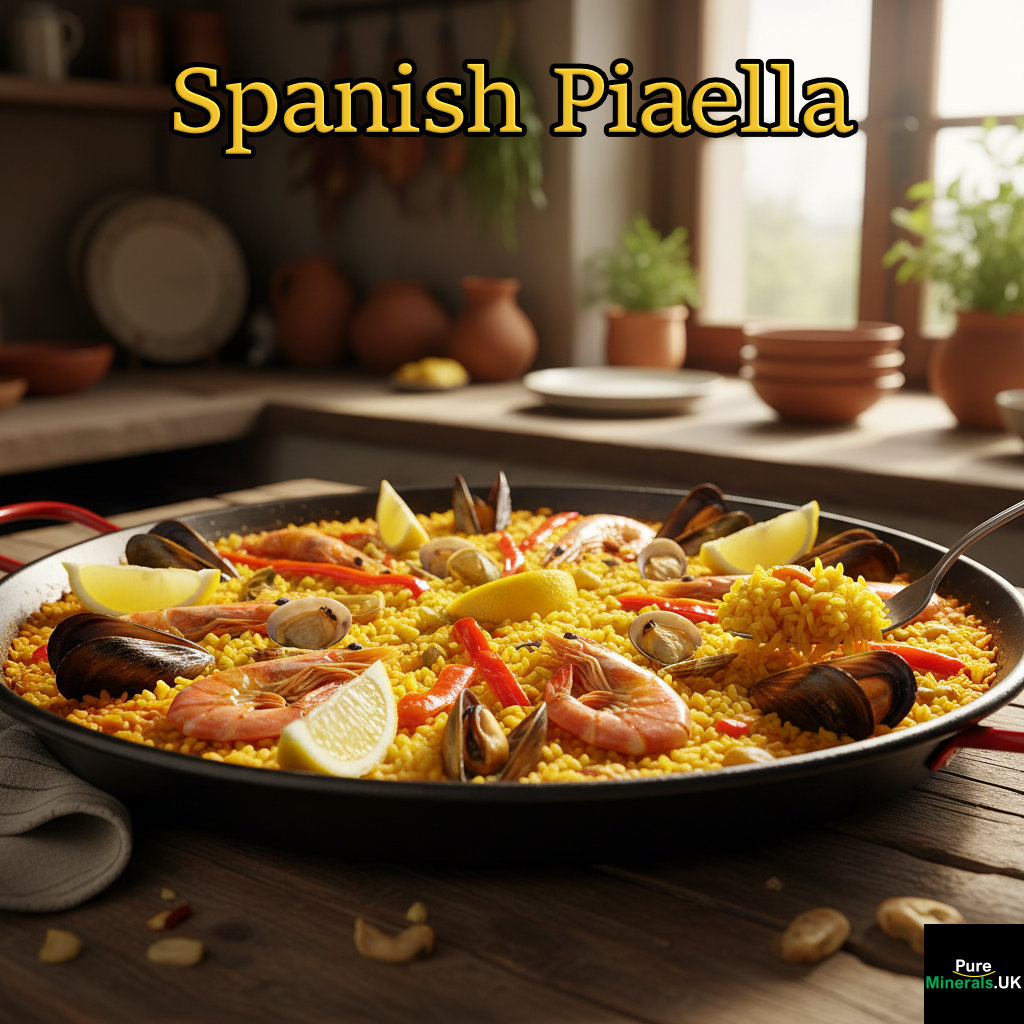
This iconic dish from Valencia showcases saffron’s ability to transform a humble rice dish into a feast for the senses. The technique involves blooming saffron in warm broth before adding it to short-grain rice, allowing each grain to absorb the golden color and distinctive flavor. Traditional paella incorporates local ingredients like rabbit, snails, and beans, though seafood variations are now equally beloved. The signature crispy bottom layer (socarrat) develops as the rice cooks in a wide, shallow pan, creating textural contrast with the tender, saffron-infused rice above.
2. Persian Rice (Tahdig)
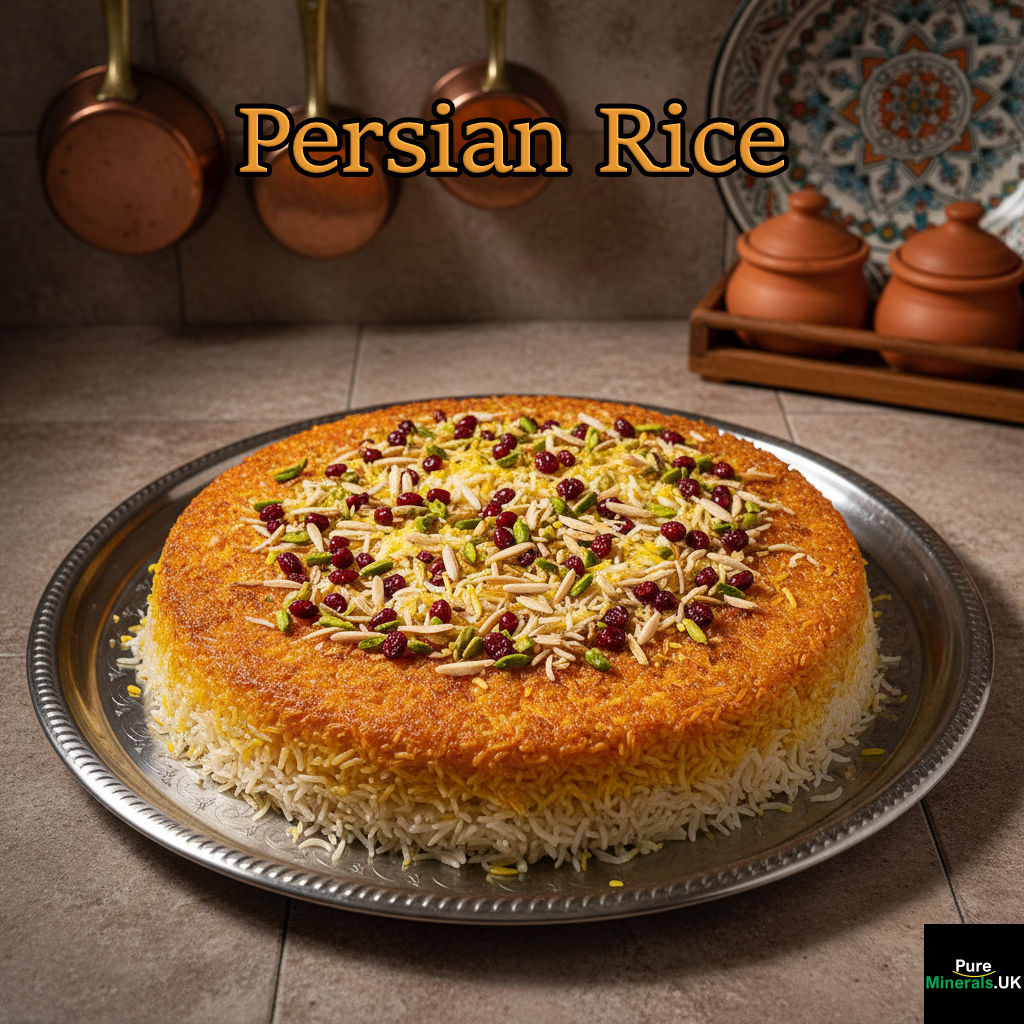
In Persian cuisine, saffron elevates rice to an art form through dishes like jeweled rice (javaher polow) and the crispy-bottomed tahdig. The preparation involves partially cooking rice, then layering it with saffron-infused water and slow-cooking until a golden crust forms on the bottom. This preparation showcases saffron’s visual impact – the golden threads are often mixed with just a portion of the rice, creating a beautiful contrast when served. Persian rice dishes typically incorporate dried fruits, nuts, and herbs that complement saffron’s complex flavor profile.
3. Indian Kesar Milk
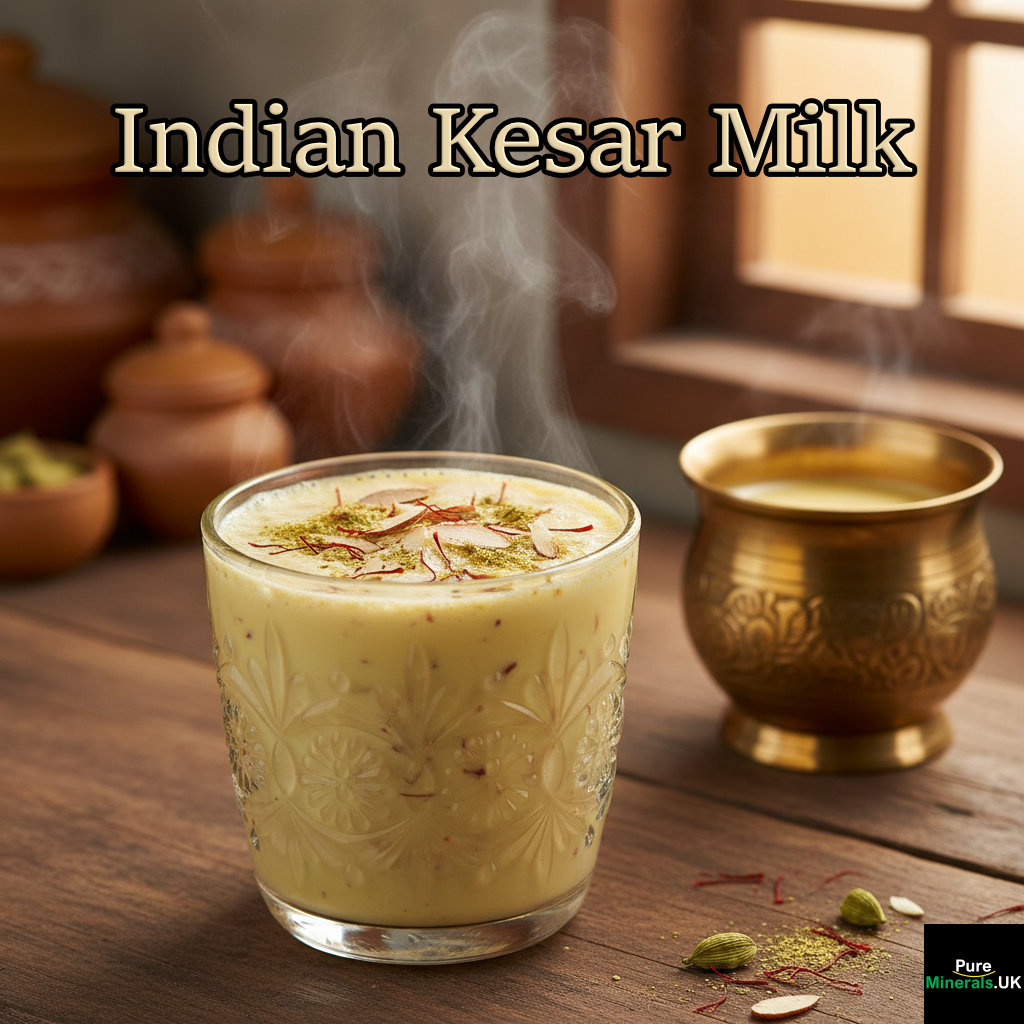
This warming beverage demonstrates saffron’s affinity for dairy and its therapeutic potential. Saffron threads are steeped in hot milk with cardamom, almonds, and a touch of sweetener, creating a comforting drink that doubles as a traditional remedy for everything from insomnia to respiratory conditions. The fat in the milk extracts saffron’s flavor compounds while making its beneficial components more bioavailable. Modern variations might include a touch of turmeric for additional anti-inflammatory benefits or rosewater for floral notes.
How to Store Saffron to Preserve Its Potency
Ideal Container Types
Proper storage is essential for maintaining saffron’s flavor, aroma, and medicinal properties. The ideal container for saffron is airtight, opaque, and made of glass or tin rather than plastic, which can impart unwanted flavors and allow air exchange. Some traditional saffron containers feature a second inner lid or paper wrapping to provide additional protection from air and light, similar to how mastic resin is often stored to preserve its unique properties.
Many culinary experts recommend storing small amounts of saffron in separate containers rather than repeatedly opening one large container, as each exposure to air and light diminishes potency. If you purchase saffron in bulk, consider dividing it into smaller portions for long-term storage, keeping just a small amount accessible for regular use.
Temperature and Light Considerations
Saffron’s precious compounds degrade when exposed to heat, light, and moisture. For maximum longevity, store your saffron in a cool, dark place away from the stove, direct sunlight, or humidity sources. While refrigeration is not necessary, it can extend saffron’s shelf life, particularly in warm or humid climates. If refrigerating, ensure the container is completely airtight to prevent moisture absorption.
When properly stored, high-quality saffron can maintain its potency for up to three years, though its peak flavor and therapeutic properties are strongest within the first year after harvesting. You’ll know your saffron is past its prime when the color appears dull, the aroma becomes faint, or the threads break apart easily. Even older saffron remains safe to use, but you may need to increase the quantity to achieve the desired flavor and color.
The Different Varieties of Saffron
Spanish Saffron: Bold and Aromatic
Spanish saffron, particularly varieties from La Mancha, is prized for its bold aroma and distinctive flavor profile. The threads tend to be slightly thicker than other varieties and often retain a small portion of the yellow style attached to the red stigma, giving them a characteristic appearance. Spanish saffron is typically toasted slightly during processing, which intensifies its aroma but can make the color slightly less potent than Persian varieties.
Culinarily, Spanish saffron shines in robust dishes where its pronounced flavor can stand up to other strong ingredients. It’s the traditional choice for paella, hearty stews, and seafood dishes around the Mediterranean. For therapeutic applications, Spanish saffron offers good levels of safranal (responsible for aroma) but may contain slightly lower concentrations of crocin than top-grade Persian varieties
Traditional Skin Brightening Remedies
Saffron has been treasured in traditional beauty rituals for centuries, particularly for its skin-brightening properties. Ancient Persian and Indian beauty practices often featured saffron masks designed to even skin tone and create a natural luminosity. The combination of powerful antioxidants and anti-inflammatory compounds in saffron helps reduce hyperpigmentation and protect skin cells from environmental damage that can cause dullness and uneven tone.
To create a simple yet effective brightening mask, soak 5-6 saffron threads in a tablespoon of raw honey for 10 minutes, then gently blend in a teaspoon of pure yogurt. Apply to clean skin and leave for 15-20 minutes before rinsing with lukewarm water. Regular application (1-2 times weekly) can gradually reduce the appearance of sun spots, acne scars, and general discoloration while nourishing the skin with beneficial nutrients.
Calming Bath Rituals for Stress Relief
The aromatic compounds in saffron, particularly safranal, have been shown to have anxiety-reducing and mood-stabilizing effects when inhaled or absorbed through the skin. Create a luxurious stress-relieving bath by steeping 15-20 saffron threads in hot water for 20 minutes, then adding this golden infusion to your bathwater along with a tablespoon of milk or light carrier oil. As you soak, the saffron’s bioactive compounds are absorbed through your skin while its distinctive aroma creates a sensory experience that calms an overactive nervous system and promotes deep relaxation.
Aromatherapy Uses for Better Sleep
Saffron’s unique aromatic profile makes it valuable for promoting restful sleep and quieting an overactive mind. Studies suggest that safranal, the compound responsible for saffron’s distinctive scent, may influence serotonin and dopamine pathways in ways that support healthy sleep patterns. Try placing a small sachet containing a few saffron threads near your pillow, or add 2-3 threads to a warm cup of milk with a touch of honey about 30 minutes before bedtime. The gentle, earthy-sweet aroma creates a sensory cue that signals your body and mind to prepare for deep, restorative sleep. For more on calming herbs, explore the benefits of rosemary in aromatherapy.
How to Use Saffron as a Natural Remedy
Harnessing saffron’s therapeutic potential requires understanding proper preparation methods that maximize bioavailability while minimizing waste of this precious spice. Unlike many supplements that work through isolated compounds, saffron’s benefits appear to come from the synergistic effect of multiple bioactive substances working together. This explains why traditional preparations often yield better results than isolated extracts, though standardized supplements certainly have their place in therapeutic applications.
Saffron Tea for Mood Enhancement
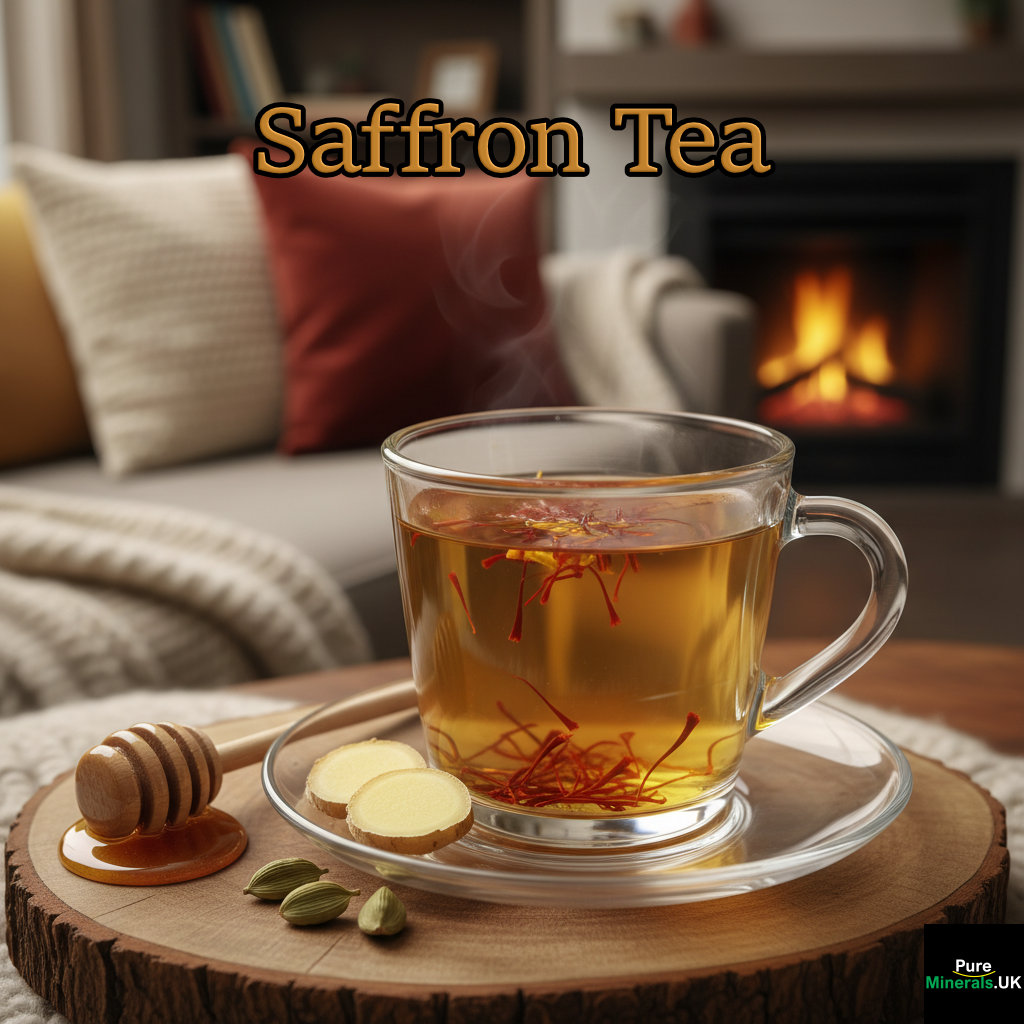
One of the simplest and most effective ways to experience saffron’s mood-lifting properties is through a daily cup of saffron tea. Begin by crushing 5-7 saffron threads between your fingers to release their volatile compounds. Add the crushed threads to a cup of hot (not boiling) water, cover, and allow to steep for 10-15 minutes. For enhanced flavor and additional benefits, consider adding complementary ingredients like a slice of ginger, a cardamom pod, or a touch of honey.
This simple preparation provides a gentle but noticeable lift to mood and energy levels, particularly when consumed consistently over time. Many people report feeling a subtle sense of clarity and emotional balance within 20-30 minutes of drinking saffron tea, with cumulative benefits developing over weeks of regular use. For maximum therapeutic effect, try having a cup mid-afternoon when cortisol levels naturally dip and mood can become vulnerable to fluctuation.
Topical Applications for Skin Conditions
Beyond cosmetic applications, saffron offers legitimate therapeutic benefits for various skin conditions. The anti-inflammatory and antimicrobial properties of saffron make it valuable for soothing irritated skin and supporting healing.
For localized irritation or mild eczema, create a paste by grinding 8-10 saffron threads with a few drops of rosewater, then adding enough aloe vera gel to form a spreadable consistency. Apply to affected areas twice daily, allowing to absorb completely. The crocin and crocetin in saffron help calm inflammation while safranal’s mild antimicrobial properties help protect vulnerable skin from opportunistic infections. For other natural remedies, you might explore the benefits of mastic resin for skin health.
Proper Dosage for Therapeutic Benefits
While culinary amounts of saffron are generally safe for everyone, therapeutic doses require more careful consideration. Clinical studies typically use standardized extracts providing 30-200mg of saffron daily, depending on the condition being addressed. When using whole saffron threads, this translates to approximately 10-30 threads daily for most therapeutic applications. Start with the lower end of this range (about 10 threads daily, divided into two doses) and gradually increase if needed. It’s worth noting that saffron can have mild anticoagulant effects at higher doses, so those taking blood-thinning medications should consult a healthcare provider before using saffron therapeutically.
Adding This Golden Spice to Your Wellness Routine
Incorporating saffron into your daily life doesn’t need to be complicated or expensive. Begin with small, consistent amounts rather than occasional large doses – a few threads added to your morning tea, afternoon rice, or evening milk provides gentle but cumulative benefits for mood, cognition, and overall wellbeing. Consider keeping a small container of saffron water (made by soaking a few threads in water overnight) in your refrigerator to add a splash of golden goodness to various foods and beverages throughout the day.
Whether you’re seeking specific therapeutic effects or simply wishing to enhance your meals with this extraordinary spice, consistency is key to experiencing saffron’s full spectrum of benefits. For personalized guidance on using saffron for specific health conditions, Herbazest offers comprehensive resources on dosage, preparation methods, and potential interactions.
Frequently Asked Questions
Saffron’s unique properties and high value naturally generate many questions about its proper use, potential benefits, and important precautions. Here are answers to some of the most common inquiries about this extraordinary spice. If you’re interested in exploring more about other spices, check out this article on oregano and its benefits.
How much saffron should I use in cooking?
For culinary purposes, a little saffron goes a remarkably long way. Most recipes call for between 1/4 to 1/2 teaspoon of threads (approximately 15-30 threads) to flavor an entire dish serving 4-6 people. Using too much can create an overwhelming medicinal taste and may waste this precious ingredient. The key to maximizing flavor is proper blooming – steeping the threads in hot liquid for at least 15 minutes before adding to your recipe. This process activates and distributes the flavor compounds more effectively than simply adding dry threads directly to your cooking.
Can saffron be harmful or have side effects?
Saffron is generally safe when consumed in typical culinary amounts (up to about 1.5 grams per day). However, excessive consumption (more than 5 grams daily) can cause nausea, vomiting, dizziness, and other unpleasant symptoms. Pregnant women should be particularly cautious, as traditional wisdom and some research suggest that very high doses may stimulate uterine contractions. Those with bipolar disorder should consult a healthcare provider before using saffron therapeutically, as its mood-elevating effects might potentially influence manic episodes. Individuals taking prescription medications, particularly blood thinners or antidepressants, should also seek professional advice before using saffron in medicinal amounts.
What’s the difference between saffron and safflower?
Despite sometimes being marketed as “Mexican saffron” or “American saffron,” safflower (Carthamus tinctorius) is an entirely different plant from true saffron (Crocus sativus). Safflower produces bright yellow-orange petals that are sometimes used as an economical coloring agent, but it lacks the distinctive flavor and therapeutic compounds found in genuine saffron. Visually, safflower threads are more uniformly thin and straight compared to saffron’s trumpet-shaped stigmas that broaden at one end. For a similar coloring agent, you might consider using paprika in your culinary creations.
While safflower has its own legitimate culinary uses and health benefits (particularly its oil, which is rich in heart-healthy unsaturated fats), it cannot substitute for saffron in dishes where the characteristic flavor is important. From a therapeutic perspective, the two plants have entirely different compound profiles and medicinal properties, making them non-interchangeable for health applications.
How long does saffron last before losing potency?
- Properly stored saffron threads can maintain good quality for up to 3 years, though peak potency occurs within the first 12 months after harvest.
- Saffron powder has a significantly shorter shelf life, typically maintaining optimal quality for only 6-12 months before noticeable degradation.
- Exposure to light, heat, and air accelerates the breakdown of saffron’s valuable compounds, so storage conditions matter more than chronological age.
- You can test your saffron’s potency by placing a few threads in warm water – fresh, potent saffron should release a rich golden color and distinct aroma within minutes.
When stored properly – in an airtight, opaque container away from heat and light – high-quality saffron maintains its therapeutic and culinary properties remarkably well. The natural oils that give saffron its distinctive aroma are typically the first components to diminish, so a reduction in fragrance is often the earliest sign that your saffron is past its prime.
If your saffron has lost some potency but isn’t completely degraded, you can still use it by slightly increasing the quantity called for in recipes. For therapeutic applications, however, it’s best to use saffron within its first year when bioactive compounds are most concentrated.
Some connoisseurs suggest storing saffron threads whole rather than ground, as the intact structure helps protect the inner compounds from oxidation. If you do purchase saffron powder (generally not recommended due to the ease of adulteration), choose only the smallest quantity you’ll use within a few months.
To maximize longevity, avoid the common mistake of storing saffron in plastic containers, which can allow air exchange and may impart unwanted flavors. Instead, choose glass, ceramic, or metal containers with tight-fitting lids. Some traditional saffron vessels include an inner paper wrapping that helps absorb any residual moisture – a simple yet effective preservation technique.
Can I grow saffron at home?
Growing your own saffron is entirely possible and can be deeply rewarding, though it requires patience and specific conditions. Crocus sativus corms can be planted in late summer for autumn flowering, with each bulb potentially producing multiple flowers annually. The plants prefer well-drained soil, full sun to partial shade, and a distinct cold period in winter followed by hot, dry summers. Container growing works well for saffron, allowing better control over soil conditions and making harvest more manageable.
Be realistic about yield expectations – each flower produces just three stigmas, so a modest home garden with 50-100 bulbs might yield only a gram or two of finished saffron annually. However, the process of harvesting and processing your own saffron connects you to an ancient agricultural tradition while providing the freshest possible product. Home growers typically find that their personally harvested saffron has exceptional vibrancy and potency compared to commercial products that may have been stored for months before purchase.
Saffron, often referred to as the golden spice, is renowned for its vibrant color, distinct flavor, and potential health benefits. It is derived from the flower of Crocus sativus, and its rich history dates back to ancient times. The labor-intensive harvesting process makes saffron one of the most expensive spices in the world. For those interested in exploring more about this fascinating spice, you can find everything to know about saffron and its uses.
